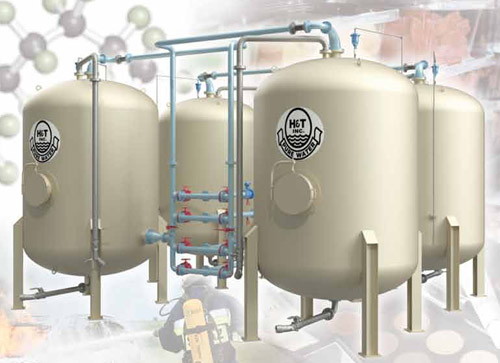Ingenious PFAS Therapy Solutions for Safer Water
The boosting frequency of PFAS contamination in water supplies necessitates an essential examination of ingenious therapy solutions. Additionally, emerging bioremediation methods supply a more sustainable method to dealing with PFAS obstacles. pfas management.
Review of PFAS Contamination
PFAS contamination has become a substantial ecological and public wellness concern. Per- and polyfluoroalkyl compounds (PFAS) are a group of artificial chemicals recognized for their perseverance in the environment and body, leading them to be generally referred to as "permanently chemicals." These compounds have been commonly utilized in different industries, consisting of firefighting foams, water-repellent fabrics, and food packaging, mainly as a result of their water- and grease-resistant properties.
The extensive use of PFAS has resulted in their detection in dirt, water materials, and also in the blood of humans and animals. Studies have connected PFAS direct exposure to various wellness problems, including developmental results in babies, immune system dysfunction, and various forms of cancer cells. Furthermore, the environmental persistence of these substances complicates their destruction and removal, raising issues about long-term eco-friendly effects.
Regulatory bodies are significantly implementing rigorous guidelines to monitor and lower PFAS degrees in drinking water and various other environmental tools. As understanding of PFAS contamination expands, it has become crucial for communities and industries to look for efficient therapy options to reduce direct exposure and protect public wellness.
Advanced Filtering Technologies
As the urgency to attend to PFAS contamination increases, progressed filtration modern technologies have become a critical part in the remediation initiatives targeted at removing these consistent chemicals from water sources. These modern technologies leverage innovative mechanisms to successfully target and capture PFAS compounds, which are infamously immune to traditional therapy approaches.
One of one of the most promising methods is making use of granular activated carbon (GAC), which adsorbs PFAS molecules because of its high area and porous structure. This technique has been commonly carried out in both municipal and industrial setups, showing significant reductions in PFAS focus. In addition, ion exchange resins have gotten grip, specifically developed to precisely bind PFAS ions from water, therefore promoting their elimination.
Membrane layer purification innovations, such as reverse osmosis and nanofiltration, additionally reveal efficacy in PFAS removal by physically dividing impurities from water - pfas management. These systems can accomplish high levels of purity, making them appropriate for drinking water applications
Chemical Therapy Technologies
Numerous chemical treatment innovations are being explored to effectively deal with PFAS contamination in water supplies. One promising approach entails making use of innovative oxidation procedures (AOPs), which make use of effective oxidants such as ozone, hydrogen peroxide, or chlorine dioxide integrated with UV light to break down PFAS compounds into much less harmful materials. This technique has actually demonstrated efficacy in laboratory setups, revealing prospective for scalability in real-world applications.
Another innovative approach is the growth of ion-exchange materials particularly created to target PFAS. These resins can precisely adsorb PFAS compounds from water, enabling their removal throughout treatment processes. Recent advancements have improved the performance and ability of these resins, making them a positive option for water treatment centers.
Furthermore, researchers are exploring making discover here use of chemical agents like persulfate and ferrous ions to enhance the destruction of PFAS in polluted water. These representatives can cause chain reaction that facilitate the failure of consistent PFAS substances.
Emerging Bioremediation Strategies
Recent advancements in chemical therapy innovations have actually led the method for discovering bioremediation methods as a practical choice for dealing with PFAS contamination. Bioremediation uses the natural metabolic procedures of microorganisms to break down or transform pollutants, making it an enticing strategy for dealing with persistent pollutants like PFAS.
Arising techniques in bioremediation include using genetically engineered bacteria that can especially target and break down PFAS substances. These microbial strains are being established for their boosted degradation abilities, raising the efficiency of the remediation procedure. Additionally, researchers are checking out the potential of plant-assisted bioremediation, where certain plant types might uptake and withdraw PFAS from contaminated soil and water.
One more encouraging approach is the application of bioaugmentation, which involves introducing advantageous microorganisms right into infected settings to increase the deterioration of PFAS. This technique can promote much faster remediation timelines and enhance general performance.

Governing Frameworks and Criteria
An extensive regulative structure is crucial for effectively managing PFAS contamination and guaranteeing public health and wellness security. The boosting acknowledgment of per- and polyfluoroalkyl compounds (PFAS) as ecological contaminants has actually prompted different federal recommended you read and state companies to establish requirements that govern their presence in water supplies. The U.S. Epa (EPA) has actually developed wellness advisories and is pursuing setting enforceable restrictions for PFAS in drinking water.
State-level regulations vary significantly, with some states taking on more stringent guidelines than those suggested by the EPA. These laws often consist of maximum impurity degrees (MCLs) for details PFAS compounds, tracking demands, and reporting obligations for water utilities. Furthermore, arising structures concentrate on the remediation of infected sites, emphasizing the demand for efficient therapy innovations.

Verdict
Finally, the advancement and application of ingenious PFAS therapy options are vital for dealing with the pervasive problem of water contamination. Advanced filtration technologies, chemical treatments, and emerging bioremediation methods collectively offer a diverse approach to efficiently lower and break down PFAS degrees. As regulatory frameworks continue to evolve, integrating these innovations will certainly be important to secure public health and bring back the stability of infected water resources, ultimately adding to a cleaner and safer setting.